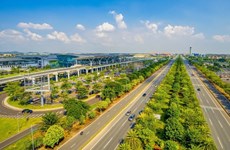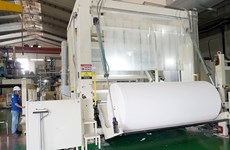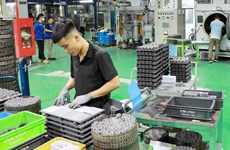Numbers of firms, employees in FDI, non-state sectors soar: census
The numbers of enterprises and employees working in the non-state and FDI sectors increased rapidly, but reduced markedly in the state-owned sector during 2016-2020, according to the General Statistics Office of Vietnam (GSO)’s freshly released 2021 economic census.
 Workers make garment products at Apparel Far Eastern Vietnam Co. in Binh Duong province. (Photo: VNA)
Workers make garment products at Apparel Far Eastern Vietnam Co. in Binh Duong province. (Photo: VNA) The non-state sector had 660,100 businesses in 2020, accounting for 96.4% of Vietnam’s total, up 35.1% from 2016. The sector attracted 8.6 million workers, or 58.6% of the country’s workforce, increasing by 0.4% compared to 2016.
The FDI sector, meanwhile, had the fastest growth rate in the number of enterprises and made up an increasingly large share of the total number of jobs created. There were 22,200 foreign-funded firms, accounting for 3.3% of the total and soaring by 58.8% against 2016. They employed 5.1 million workers, 34.6% of the workforce and a growth of 22.5% from 2016.
Due to the state's policy of equitisation and rearrangement, the state-owned sector experienced continuous decreases during this five-year period. Its total number of firms stood at 1,963 enterprises in 2020, or 0.3% of the total, dropping by 26.3% compared to 2016. One million employees were hired in the year, accounting for 6.8% of the workforce, down 21.8% against 2016.
As of December 31, 2020, state-owned enterprises boasted the largest scale, with 512.4 employees, followed by FDI enterprises with 228.9. Private enterprises had an average only 13 employees.
In addition, the numbers of businesses and workers were growing rapidly in the Red River Delta and the Southeast region, which house the two largest economic centres in the country – Hanoi and Ho Chi Minh City. The southeast region registered 281,100 enterprises as of December 1, 2020, or 41.1% of the country's total, up 32.2% from 2016. The Red River Delta region registered 216,800 enterprises or 31.7%, an increase of 36.8% after five years.
Domestic and foreign investments channeled into enterprises have maintained a rapid growth rate in the period. The scale of enterprises had been expanded mainly based on the capital factor instead of labour, with non-state enterprises luring the most capital.
The census had a large scale and complex content, covering enterprises, household production and trade establishments, non-business establishments, associations, and religious establishments./.













